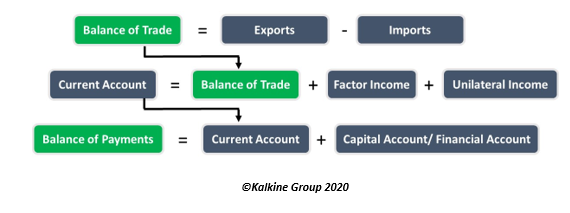Definition
Related Definitions
Balance of Trade
What is meant by Balance of Trade?
Balance of Trade (BOT) refers to the difference between the value of exports and imports of a country for a given period. Balance of Trade is a component under the Balance of Payments, which is a balance sheet maintained by a country for all types of international transactions related to assets, goods, loans and others. Balance of Trade is added to Factor Income and Unilateral Income under the current account in BOP.
If the exports of a country exceed its imports, then there exists a BOT surplus. And if the imports of a country exceed its exports, then the country is said to have a BOT deficit.
A Balance of trade surplus is favourable while a deficit is unfavourable for a country. However, a deficit in the balance of trade might not always have adverse implications. Many countries continue to function with a BOT deficit. For them, a deficit simply means that they have a large dependency on imports.
Larger imports are an important factor in determining any economy’s strength; however, they may not always indicate an alarming situation in the domestic economy.
Are Balance of Trade and Balance of Payments same?
Balance of Trade hugely impacts the Balance of Payments. However, a deficit or surplus in one does not always mean the same for the other. For instance, countries having a BOP surplus might also be observing a BOT deficit at the same time.

Notably, implications of a BOP deficit/surplus and a BOT deficit/surplus are different for an economy.
What are the factors affecting a country’s Balance of Trade?
- Domestic competitiveness: Abundance of factors of production, a good amount of resource endowment, and technological advancement in production are some of the factors that affect the competitiveness of a country. For a country that has abundant endowment of labour, the exports would be greater of those goods that are labour-intensive.
Thus, the endowment of factors of production, namely, labour, capital, and land, affect the ability of a firm to compete in the international market. This follows from the Hecksher-Ohlin theory of trade.
On the other hand, Ricardian model of international trade suggests that a country would export the good in which it enjoys a ‘comparative advantage’. This means that any country that has better productivity levels due to increased technology and better equipment would have more exports in that good, even if other countries are also producing that good.
- Inflation Rate: If a country has a higher level of prices than its trade partner, then domestic consumers would prefer imports. This could hurt the domestic producers and in turn put pressure on the Balance of Trade.
- Exchange Rate: If the domestic currency appreciates then foreign goods start to appear cheaper as compared to domestic goods. Thus, it could lead to exports falling and imports increasing.
- Demand-Supply: The demand of a good impacts the price level of that good. In case of insufficient domestic supply, the prices of a good might rise in the home country, thus making them more expensive as compared to foreign alternatives. On the contrary, in case of insufficient domestic demand, prices would decrease thus making domestic goods cheaper as compared to foreign alternatives.
- Foreign Exchange Reserves: Foreign exchange reserves enable the countries to increase their competitiveness so that they are at par with foreign producers, in terms of equipment, machinery and production methods.
What does a deficit or a surplus in BOT mean for a country?
A surplus in BOT simply indicates that the value of goods exported exceeds the value of goods imported. Thus, a surplus in BOT might indicate that an economy is going in a positive direction. However, there is no absolute conclusion that can be drawn from a positive or negative BOT.
A positive BOT might provide sufficient aid to domestic operations and could provide fiscal assistance. However, it could also mean underutilisation of resources. Also, if a prolonged surplus is spent by an economy suddenly then it might be the cause of disruptions in the economy.
On the other hand, a deficit can also be the consequence of a changing business cycle. It could also mean that a country has an increased demand, even if the demand is for imports. Increased demand means that consumer spending is on the rise and the economy is expanding. This is one of the most important pushes needed by growing economies to enhance their economic growth.
It is not right to oversimplify the surplus as ‘good’ and deficit as ‘bad’ for the economy, as it is important to note the cause of either of those circumstances. Moreover, domestic policies, productivity levels, trade laws and various other factors are important determinants of how strong the economy of a country is compared to that of its trading partners.
